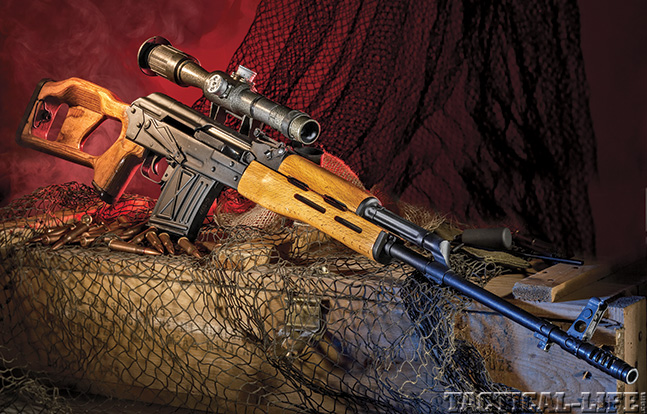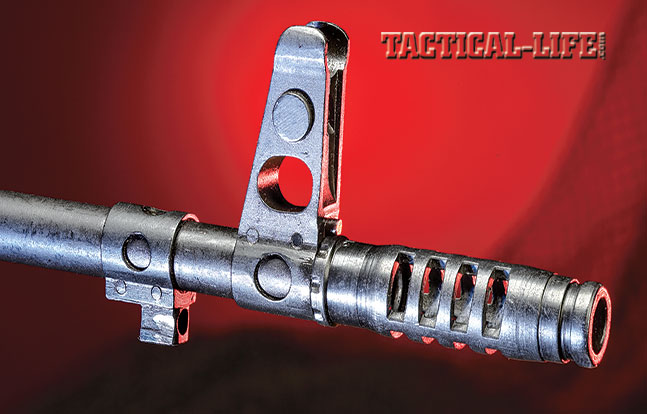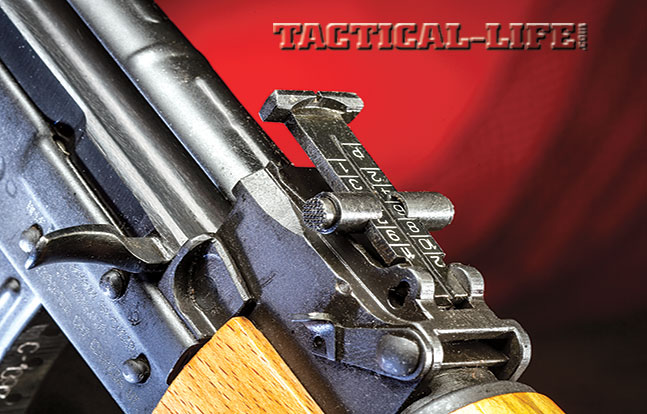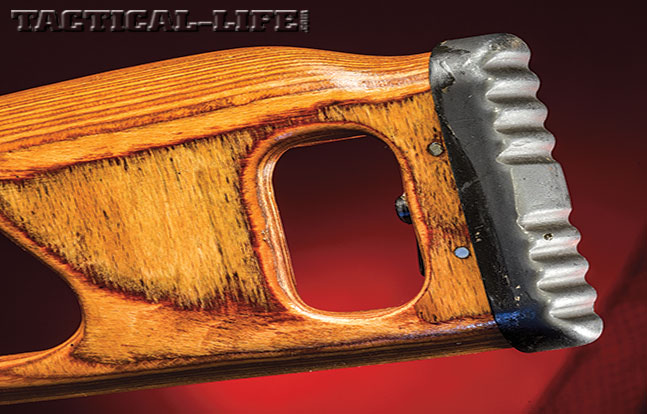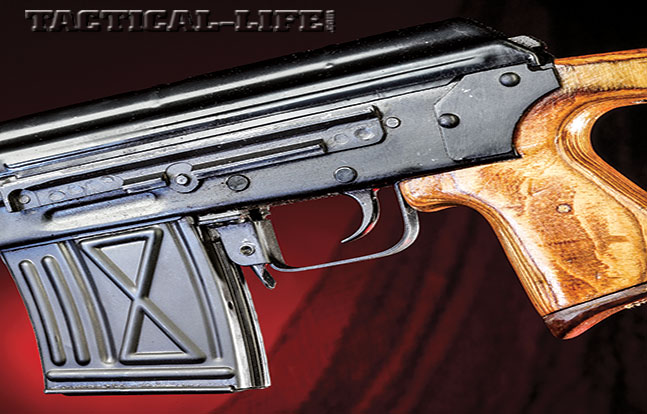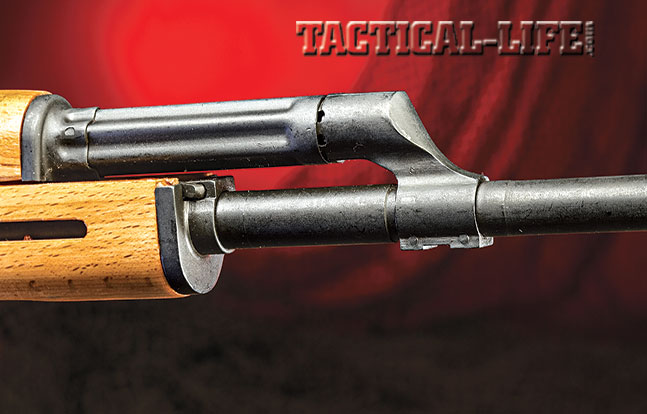Kalashnikov pattern rifles are many things—rugged, reliable, and brutally efficient. Produced in mind-blowing numbers around the world during the Cold War era and continuing on through today, the Kalashnikov AK is king of the wars in almost all of the hotspots in the world today. Nevertheless, there is one thing that it most-definitely is not — accurate.
In situations where greater range, accuracy and power than a traditional AK is needed, the answer comes in a Romanian-made semi-automatic precision rifle dubbed the PSL. Chambered in the more powerful 7.62x54R rimmed cartridge, the PSL series provides greater long-range capabilities than the AK and has seen action on both sides of the War on Terror.
Despite its widespread use around the world, the Romanian PSL series of rifles suffer from a serious case of mistaken identity. Due to generally similar exterior lines and similar roles, this rifle is often confused with the SVD rifle and many times incorrectly referred to as a Romanian “Dragunov.” In reality, the two rifles could not be more different.
Advertisement — Continue Reading Below
Officially dubbed the Samozaryadnaya snaiperskaya vintovka Dragunova (or SVD for short), the SVD is a 7.62x54R-chambered semi-automatic rifle, adopted by the Soviet Army in 1963, that offers a greater rate of fire through its detachable box 10-round magazine than earlier World War II-era Soviet M91/30 bolt-action sniper rifles, but with better accuracy and range than an AK.
The SVD has uniquely Eastern lines that are generally reminiscent of a Kalashnikov-pattern rifle. However, it is internally quite different from the infamous AK. In particular, the SVD’s short stroke piston system results in a lighter bolt carrier than in the Kalashnikov rifle, which features a large and heavy gas piston/bolt carrier assembly. To further enhance accuracy, the SVD’s forend is affixed directly to the receiver for less barrel disturbance—also at odds with the Kalashnikov design.
Another Contender
Advertisement — Continue Reading Below
As the SVD was adopted as the standard precision rifle of the Soviet Union, what exactly is the Romanian PSL rifle and why does it exist? Rather than simply adopting is own variant of the SVD rifle, the Soviet-era satellite state of Romania decided to develop its own precision rifle through its well-developed and highly capable domestic arms production facilities. In particular, the PSL (which stands for Puşcă Semiautomat cu Lunetă or “semi-automatic rifle with scope”), is a variant produced by the Romanian arms manufacturer SC Fabrica de Arme Cugir SA (or “Technical Products Factory Cugir”), a facility with a two century-old tradition in armsmaking.
Introduced into Romanian armed forces in the late 1970s/early 1980s, the PSL differed significantly from the SVD, despite their similar external appearances and shared 7.62x54R chambering. First and foremost, unlike the SVD, the PSL’s basic design is based off of the tried-and-true Kalashnikov rifle, although significantly enlarged and reinforced to accommodate the larger, more powerful cartridge.
As a result, the PSL represented a polar-opposite design approach from the SVD. The heart of the PSL is an elongated and reinforced stamped-steel Kalashnikov-style receiver. To handle the increased impulse stress of the full power rimmed 7.62x54R cartridge (which produces performance similar to the .30-06 Springfield cartridge) over the Kalashnikov’s standard 7.62x39mm intermediate cartridge, the PSL’s 11-inch receiver features several reinforcement points over a standard sheet metal Kalashnikov-style receiver.
Advertisement — Continue Reading Below
At the rear of the receiver are two riveted reinforcing plates where the stock meets the receiver to help the rifle withstand and spread out the heavier recoil of the more powerful cartridge. At the forward part of the receiver are two RPK-style raised reinforcing ribs around the rifle’s trunnion area, also to help add strength to the receiver. A stamped-steel top cover features reinforcing ribs in the latter-day AKM style of the Kalashnikov.
The mechanism of the PSL’s semi-automatic system of operation is also quite different. While the SVD featured a short-stroke gas piston system, the PSL employs a large, heavy bolt carrier assembly with an affixed gas piston like the Kalashnikov. In fact, the large assembly measures just under 18 inches in total length, resulting in a large mass of metal slapping back and forth during cycling. A rotating bolt head locks into a stressed-steel trunnion housed within the stamped-steel receiver.
In Practice
Advertisement — Continue Reading Below
By their nature, rifles such as the PSL and even the SVD represent a radically different approach to precision rifle design than their Western counterparts. With the PSL being born during the Cold War era, the Soviets’ view of the role of the designated marksman had a significant impact on the design of this rifle.
Whereas Western military doctrine for rifles employed in this role calls for precision rifle designs that place a premium on extreme accuracy, the Soviets focused more on rate of fire and portability. And the PSL is representative of this mindset with the overall weight of the rifle (including the PSO-1-type optical sight) coming in right around 10 pounds. As a result, the semi-automatic rifle is practically a lightweight when compared against Western designs such as the Marine Corps’ M40 series of rifles. And, feeding from a detachable box 10-round magazine, it offers a great deal of rapid firepower.
The safety of the rifle is the Kalashnikov-style combination safety lever/dustcover on the right side of the rifle’s receiver. To operate it, one must sweep the large lever downward until it stops.
Advertisement — Continue Reading Below
Due to the Kalashnikov heritage of the PSL (although the SVD is similar), the rifle features a thin stamped-steel top cover than is wholly unsuited to accepting an optical rail. As a result, the PSL features a steel accessory rail attached to the left side of the receiver to accept the rifle’s PSO-1-type optic.
The result is a system in which the rifle’s optic must be mounted to an arm that reaches up and over the receiver, resulting in the need for a very high cheekweld. To accommodate this, the PSL features a skeletonized, laminated-wood buttstock with a raised-comb cheekpiece built. The length of pull is a very short 12.5 inches.
The optic furnished with the rifle features a one-piece scope body/mount, 4x magnification, bullet drop compensation and a rangefinder grid. The scope itself sports a sliding and twist-locking sunshade extension at its front as well as a rubber end cap and collapsing rubber eyepiece. Backing up the scope is a set of Kalashnikov-style iron sights with a sliding tangent rear unit ranged out to 1,200 meters and a protected post front unit that is adjustable for windage and elevation.
Advertisement — Continue Reading Below
I recently had an opportunity to test the PSL-54C, a civilian-legal variant of the PSL design. It came with a PSO-1-type scope that does not feature a battery-powered reticle like similar Russian scopes. The rifle came with a cleaning kit, one magazine and an owner’s manual.
The fit and finish of the rifle clearly reflected the original design intent — basic and serviceable. The steel parts featured a flat black phosphated finish that was evenly applied, and the laminated buttstock and blonde wood forend had a smooth finish.
Topping off the 24.5-inch barrel of the PSL is a roughly 2-inch-long muzzle brake. It features four vents across its length on the bottom face with two sets of four vents on each side of the upper portion facing up and out on the sides. This brake attaches to the barrel just forward of the front sight base.
Advertisement — Continue Reading Below
I inspected and cleaned the rifle, made sure the scope was attached correctly and headed out to the range. Due to the shape of the cheekpiece, I was forced to forgo my southpaw condition and shoot the rifle right handed. I had a good supply of 185-grain full metal jacket boat tail Barnaul ammunition for testing, and began putting it through its paces.
The two-stage trigger, as should be no surprise on a Kalashnikov-style rifle, was stagey and creepy with a break averaging around 7 pounds. Recoil was noticeable, but not terribly unpleasant. Over the span of a few hundred rounds fired, there were no malfunctions, and accuracy average around 2.5 inches at 100 yards—not varmint rifle accuracy, but more than enough for the intended purpose of the rifle.
Final Notes
Advertisement — Continue Reading Below
Accepting the design parameters of the rifle as well as its intended purpose, the PSL series of rifles admirably accomplishes its goals. Building on the strengths of the basic Kalashnikov-pattern weapon system, the PSL manages nicely to combine the best of both worlds in one firearm.
